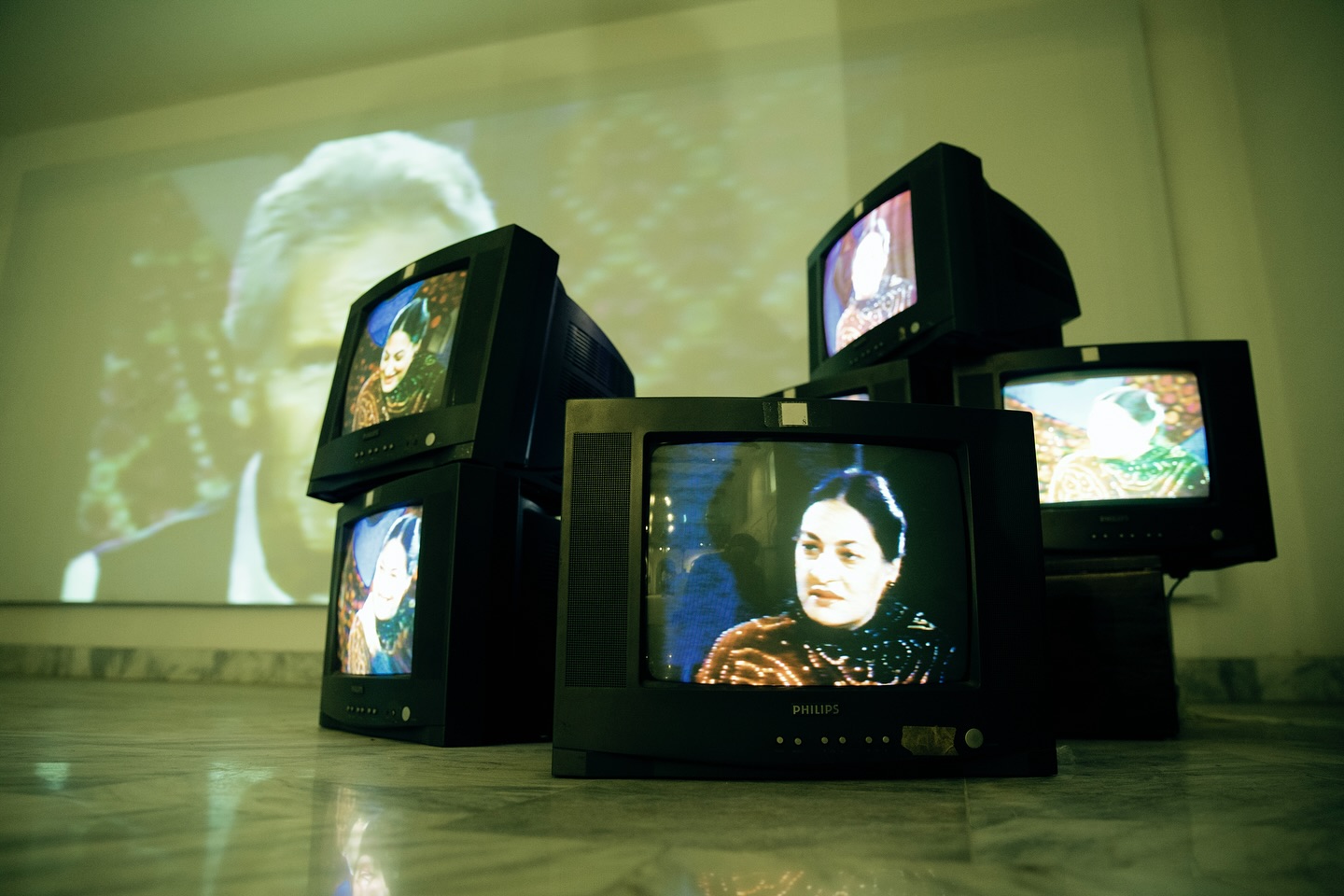Knowledge of the Ancients reveals that myriad historical, societal, cultural, and environmental factors shape our present identities. Everyone is
Knowledge of the Ancients reveals that myriad historical, societal, cultural, and environmental factors shape our present identities. Everyone is a product of inherited traditions and values—an accumulation of wisdom and lore passed down through generations. The exhibition, a collateral event to the Lahore Biennale 03, opened on 3rd October and was housed in the newly renovated Barkat Ali Islamia Hall. By situating contemporary artistic expressions within a setting deeply rooted in tradition, the exhibition embodies the idea that we are woven from the threads of our collective history.
The exhibition, curated by Zahra Khan and presented by the Art Divvy Foundation, draws out a dialogue between the heritage and architecture of the old hall and the diverse artworks displayed within it – making the space an active participant in this exchange. The decision to let works peek out from windowsills, occupy quiet corners, and use raised platforms conveys a sense of discovery to the experience, as if the artworks weren’t strategically placed but as if they naturally belong in the space. This interaction between the Barkat Ali Islamia Hall and the works underscores thoughtful curation and amplifies the meaning and impact of each piece.
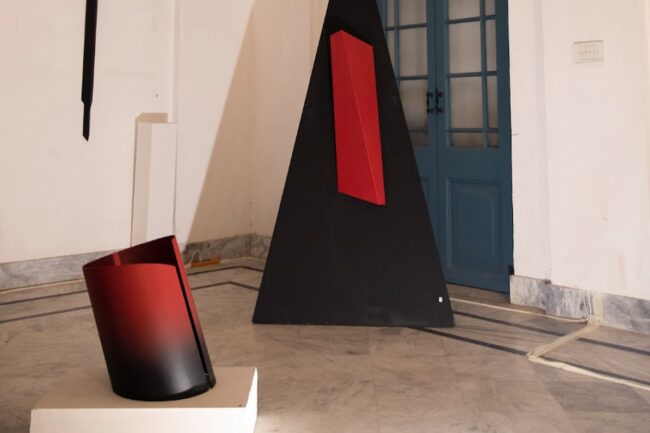
The smooth crossovers of contemporary digital media with traditional art practices in the exhibit show a clear and well-thought-out aesthetic plan. For instance, the placing of Muzammil Ruheel’s contemporary minimalistic pieces with Amra Khan’s intricate, maximalist painting stresses diverse tonalities and expressions, while also eliciting a unique cohesion. Thoughtfully placing diverse pieces—spanning various styles and media within the revitalized historic building allows for both individual expression and collective resonance, amplifying the notion of shared history and identity while also bridging the past and present.
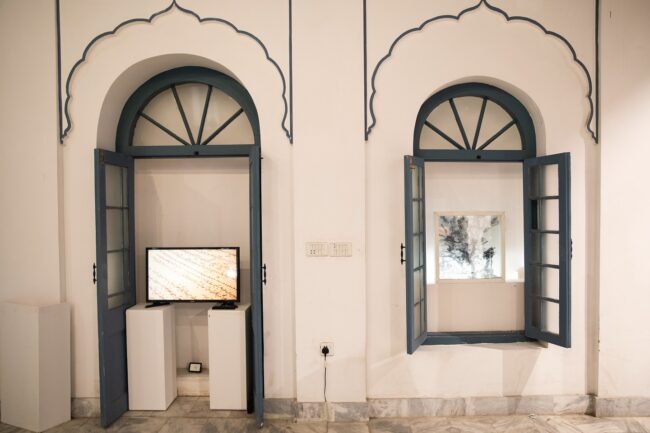
The exhibition brings together the voices of 18 artists, each addressing varied aspects of community life, from spiritual and mythical, to economic and religious concerns. This manages to encapsulate a spectrum of human experiences, conveying emotions of pain, pleasure, and within everyday life.

Saba Qizilbash’s Prince Gholam Mahomed – Calcutta to Southampton is an elaborate composition that guides the viewer along a visual and cultural journey as their eye moves from one side of the artwork to another. The work operates as an illustrated timeline of significant moments from the travels of Tipu Sultan’s last surviving son. The composition does not just amalgamate landscapes and structural spaces from India to England but also contains within it the distinct lifestyles, histories, and atmospheres of both places. The collage-like absurdity of the composition, with swift changes in perspective and scale, hints at the layering of different periods. It also stresses the fragmented nature of memory and identity. Unifying different sourced images and references, and reshaping them into one narrative, highlights the idea of selective memories shaping individual life experiences.
The menagerie of imagery in Bibi Hajra’s work adds a visceral energy to the exhibition, with untamed strokes and smudges that evoke emotions ranging from anger to sorrow- a true sense of chaos. Her apocalyptic cityscapes mourn the loss of cherished spaces, presenting scenes stripped of their magical and spiritual essence as the ecology is run into the ground. Hajra’s compositions possess a kinetic quality as one can almost feel the image move physically toward them. As the water gushes forth from the center of the image, moving downwards and out towards the viewer, it draws them into the emotional turmoil of witnessing a beloved environment laid to waste.
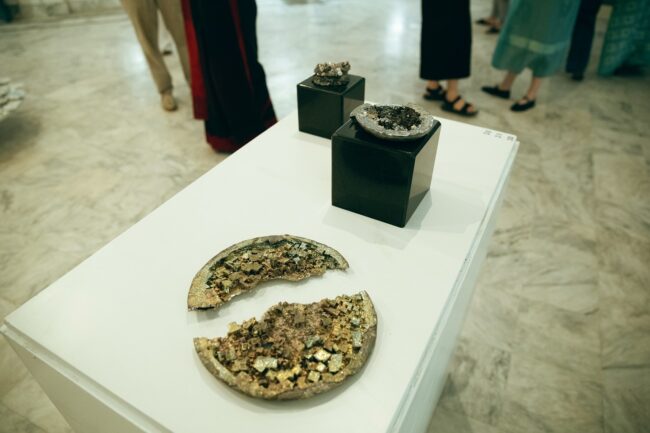
In contrast, Mamoona Riaz’s In Roads and Outwards presents a quieter meditation on urban landscapes, exploring cities as both physical structures and complex, multi-layered environments. While her paper-based works are undeniably impactful, it is Riaz’s marble piece In Roads and Outwards, that leaves the most lasting impression. Marble, traditionally a material known for its solidity and weight, contrasts sharply with the delicate, intricate designs carved into and upon its surface. The intricacy of Riaz’s designs, combined with the strength of her choice of medium, highlights the balance between resilience and fragility in urban landscapes. The precise cuts in this hard material, paired with a delicate, intricate design, embody a duality that Riaz weaves throughout her work. This juxtaposition encapsulates the idea that cities are both enduring and evolving, shaped by the interaction of unyielding structures with delicate, human-crafted details.
Furthermore, the idea of having fragmented maps on a surface hints at the individualistic character that lived spaces can acquire, due to human interaction. It also echoes the act of dissecting one’s environment bit by bit to understand what truly makes a space.
Anushka Rustomji’s Ready Made Ruin addresses themes of ephemerality, hybridity, and the concept of the sacred. The artist creates a swirling world of iconography within the work, conjuring a sense of life in flux as if the viewer is observing an entire world from a timeless, omnipresent vantage point. The chalk drawings on the brick surface create a ghostly, almost archaeological presence images seem to exist in a state of both presence and impermanence, capturing the fragility of heritage and the detachment from ancient wisdom, one’s roots, and strong connections to nature. The layout resembles a ritualistic or ceremonial pattern, almost like a mandala, suggesting something precious and sacred yet disposable and temporary. The ephemeral chalk medium accentuates the visuals already rich with historical context and symbolic meaning.
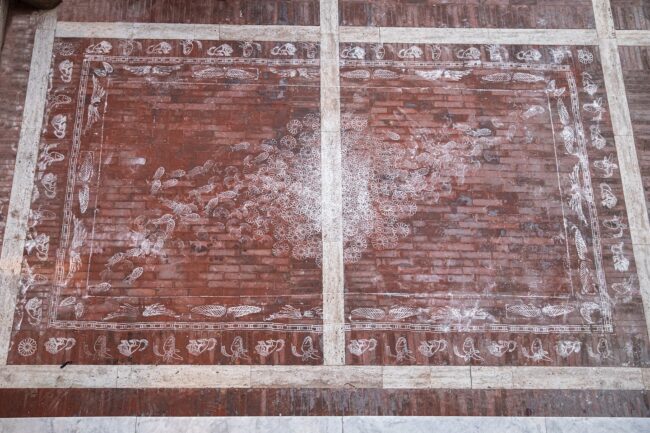
The exhibition’s exploration of transience is further embodied in Mohsin Shafi’s installation, which uses monochromatic moving imagery projected onto thin white cotton fabric. This choice of material amplifies the ephemeral quality of the video, rendering the images ghostly and insubstantial, as though they could dissipate at any moment. The delicate fabric, hanging loosely, adds a sense of tenderness and vulnerability; each slight movement from the viewer subtly shifts the projected imagery, underscoring the idea that perception is mutable and easily altered. Shafi’s work invites viewers to engage with the fleeting, intangible nature of experience, suggesting that even the most delicate shifts in our environment can transform how we understand the world around us.
Running until November 8, 2024, Knowledge of the Ancients is a testament to the enduring impact of the past on contemporary identity and artistic expression. The exhibition channels a living heritage, where each artwork serves as a portal into the cultural introspection, and rediscovery.
